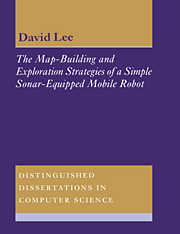 The Map-Building and Exploration Strategies of a Simple Sonar-Equipped Mobile Robot
The Map-Building and Exploration Strategies of a Simple Sonar-Equipped Mobile Robot Published online by Cambridge University Press: 05 March 2012
ARNE's application requires it to follow efficient paths to user-specified delivery points. This chapter describes how these paths are planned.
Path planning serves two purposes in this thesis. First, it is obviously necessary to move during exploration and, although some of these movements (e.g. during wall-following) may be completely reactive and not use the map, others will require ARNE to go to a specified viewpoint while avoiding known obstacles. These movements will need to be planned.
Another, less obvious, need for path planning is in the measurement of map quality. As will be seen in Chapter 10, map quality is measured by predicting how successful ARNE would be at a number of test tasks, given the latest map. Path planning is needed to make this evaluation.
Section 7.4 described the construction of a free-space map from the list of confirmed features. Path planning is based totally on this map.
The planning technique used in this thesis was first presented by Jarvis and Byrne and is described by McKerrow (1991). A ‘distance transform’ is calculated which indicates, for any given cell in the free-space map, which of the neighbouring cells is closest to the goal. This information can be used repeatedly to generate a list of cells through which the robot can reach the goal.
Section 8.1 gives a brief overview of the technique and Section 8.2 gives the implementation details.
The paths derived from the distance transform are often unnecessarily jerky, giving a zigzag path to the goal.
To save this book to your Kindle, first ensure [email protected] is added to your Approved Personal Document E-mail List under your Personal Document Settings on the Manage Your Content and Devices page of your Amazon account. Then enter the ‘name’ part of your Kindle email address below. Find out more about saving to your Kindle.
Note you can select to save to either the @free.kindle.com or @kindle.com variations. ‘@free.kindle.com’ emails are free but can only be saved to your device when it is connected to wi-fi. ‘@kindle.com’ emails can be delivered even when you are not connected to wi-fi, but note that service fees apply.
Find out more about the Kindle Personal Document Service.
To save content items to your account, please confirm that you agree to abide by our usage policies. If this is the first time you use this feature, you will be asked to authorise Cambridge Core to connect with your account. Find out more about saving content to Dropbox.
To save content items to your account, please confirm that you agree to abide by our usage policies. If this is the first time you use this feature, you will be asked to authorise Cambridge Core to connect with your account. Find out more about saving content to Google Drive.